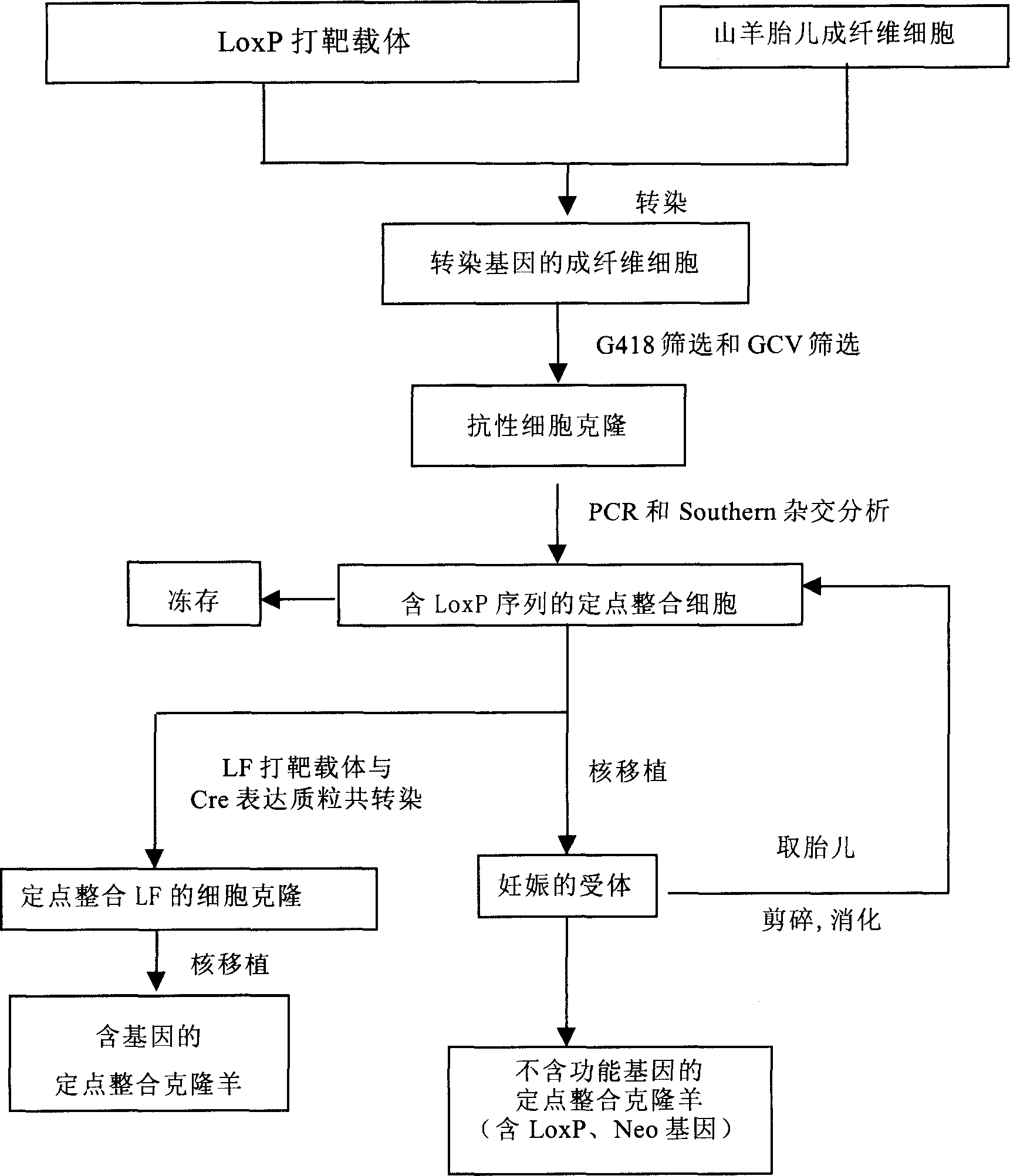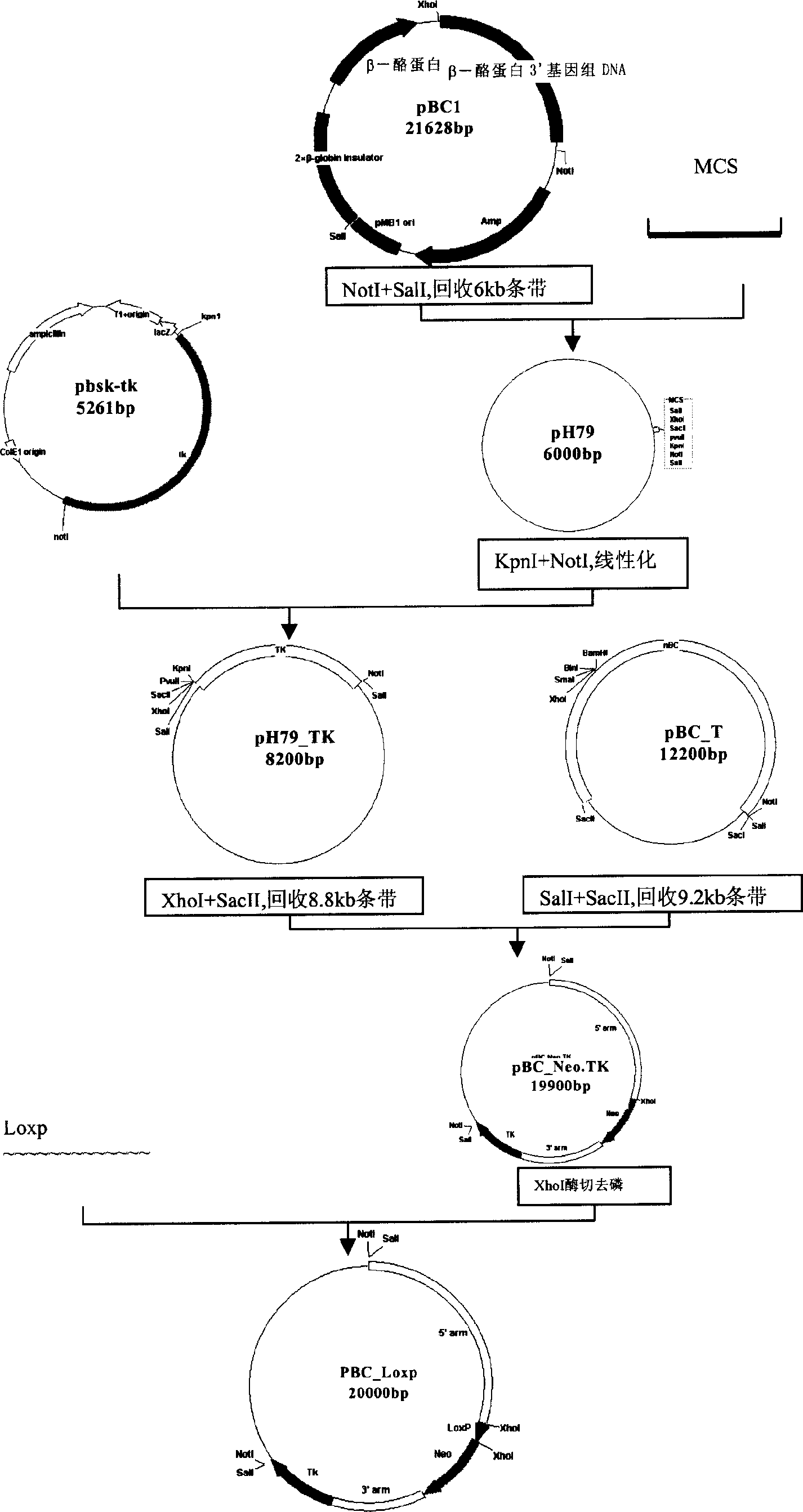Development of clone of domestic animal used as mammary gland boireactor by means of Cre-LoxP site-specific targeting somatic cell
A technique for livestock and mammary glands, applied in the field of biology
- Summary
- Abstract
- Description
- Claims
- Application Information
AI Technical Summary
Problems solved by technology
Method used
Image
Examples
Embodiment 1
[0065] Example 1 Construction of targeted targeting vector
[0066] (A) Preparation of pBC-LoxP targeting vector
[0067] Component name
SEQ ID NO
Native goat β-casein 5' homology arm
1
LoxP gene
2
Neo resistance gene
3
Native goat β-casein 3' homology arm
4
TK resistance gene
5
[0068] 1. The source of each component
[0069] 1) Native goat β-casein homology arm
[0070] According to the sequence reported by GENBANK gi:15425979, the following primers BCZ5's were designed and synthesized: TTCACGCAAAGATGGGCAC (SEQ ID NO: 6) and BC-Pc: GTCTTGGATTGCTTAGAAAACCC (SEQ ID NO: 7). Using the extracted goat genomic DNA as a template, the sequence of the first half of the 5' homology arm of β-casein was amplified by PCR (94°C, 5min; 94°C, 1min; 60°C, 45s; 72°C, 3min, 30 cycles) . The PCR product was cloned into pGEM-Teasy vector (purchased from Promega Company) to obtain plasmid pnBC51.
...
Embodiment 2
[0115] Example 2 Cell transfection screening and identification of site-specific targeting vectors
[0116] 1. Saanen Dairy Goat Fetal Fibroblasts
[0117] Saanen dairy goat fetal fibroblasts were cultured according to conventional methods. That is, the fetus was collected from a 35-day-pregnant female goat through surgery, and after removing the head, limbs and internal organs, cut it into a puree, add trypsin (0.25% Trypsin / 1mM EDTA), digest at 37°C for 20 minutes, and then add 10% FCS The DMEM culture solution was used to stop the digestion, and centrifuged at 500g for 15min. Discard the supernatant, resuspend the cells in the culture medium, inoculate into a culture bottle, and place in an incubator at 37°C, 5% CO 2 Grow and freeze.
[0118] 2. Recovery and Expansion of Goat Fibroblasts (GEF)
[0119] The cryopreserved female goat fibroblasts (GEF) were revived, placed in 37°C containing 5% CO2 incubator with DMEM / F12 culture medium with 15% fetal bovine serum, and cul...
Embodiment 3
[0149] Example 3 Preparation of cloned animals for site-specific targeting of monoclonal cells
[0150] 1 Materials and methods
[0151] 1.1. Reagents are all embryo grade reagents, unless otherwise specified are Sigma products.
[0152] 1.2 Method
[0153] 1.2.1 Collection of donated oocytes Superovulation of dairy goats was performed routinely with FSH. 29-30 hours after injection of LRH, oocytes were recovered by surgery, and fertilized with FCS containing 5% calf serum (FCS, Gibco). -10 (Gibco) culture solution was used to flush oviducts. Oocytes are collected and hyaluronidase removes attached granulosa cells. The collected oocytes were placed in M16 solution and cultured in an incubator with 5% carbon dioxide at 37.5°C.
[0154] 1.2.2 Starvation treatment of nucleated cells The monoclonal cell line with site-specific integration will be obtained. After starvation with 0.5% FCS for 72 hours, a part of the cells will be frozen and stored in a -80°C refrigerator, and re...
PUM
 Login to View More
Login to View More Abstract
Description
Claims
Application Information
 Login to View More
Login to View More - R&D
- Intellectual Property
- Life Sciences
- Materials
- Tech Scout
- Unparalleled Data Quality
- Higher Quality Content
- 60% Fewer Hallucinations
Browse by: Latest US Patents, China's latest patents, Technical Efficacy Thesaurus, Application Domain, Technology Topic, Popular Technical Reports.
© 2025 PatSnap. All rights reserved.Legal|Privacy policy|Modern Slavery Act Transparency Statement|Sitemap|About US| Contact US: help@patsnap.com



